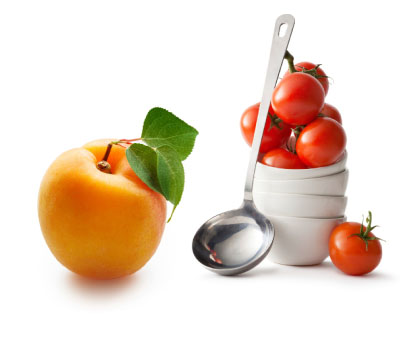Summer Produce Picks
Apricots
Health Benefits: Apricots contain vitamins A and C, both of which are known to have antioxidant properties. Apricots are also a good source of potassium, a heart-healthy mineral that helps regulate heart rate and blood pressure.
Buy It: Choose fruit with a rich orange color. The flesh should be slightly soft but not mushy.
Serve It: Slice and add to a salad, over ice cream, bake into pies or cakes or use them to make jams or jellies. Add flavor to savory chicken dishes with the addition of diced apricots.
Fun Fact: First cultivated about 4,000 years ago in China, the apricot was introduced to the United States in the 18th century.
Cucumbers
Health Benefits: Skip the multivitamin and eat a cucumber. This vegetable contains a number of B vitamins, folic acid, vitamin C, calcium, iron, magnesium, phosphorus, potassium and zinc.
Buy It: Choose cucumbers that are firm with rounded edges and a smooth, dark green skin.
Serve It: Many of the nutrients are found in a cucumber’s skin, so leave the peel on to receive their full health benefits. Use thin slices to flavor water, or use to make pickles, a chilled soup or tzatziki (a Greek condiment made with grated cucumber, plain yogurt, olive oil, vinegar and fresh dill).
Fun Fact: Cucumbers can eliminate bad breath. Hold a slice on the roof of your mouth for 30 seconds and let the phytochemicals in cucumbers kill odor-causing bacteria.
Watermelon
Health Benefits: With its high water content and being rich in potassium (a natural electrolyte), watermelon is a perfect treat for staying hydrated during the summer heat.
Buy It: Look for a watermelon with a smooth, unblemished rind. When lifted, it should feel heavy for its size.
Serve It: Fresh watermelon needs no added seasonings and flavorings. It can be eaten all on its own, but it’s also a wonderful addition to salads, fruit cocktail and frozen drinks. Use it to make a refreshing sorbet or brush slices with oil and grill just until grill marks appear.
Fun Fact: Watermelon is related to cucumbers, pumpkins and squash.
Tomatoes
Health Benefits: Tomatoes are a low calorie vegetable that are low in fat and have no cholesterol. They are rich in lycopene, a compound known to make skin less sensitive to UV light damage.
Buy It: Pick tomatoes that have a bright red color and firm, wrinkle-free skin.
Serve It: Tomatoes are a staple of Mediterranean cuisine, often found in sauces, salads and soups. Add slices to burgers, sandwiches and pizza; sprinkle halved tomatoes with grated Parmesan cheese and oregano, then grill until the cheese melts; toss cherry tomatoes into fresh summer salads or add to kabobs.
Fun Fact: According to Guinness World Record, the heaviest tomato ever was 7 lbs 12 oz.
Mangoes
Health Benefits: Mangoes are a water dense fruit that are only 100 calories per cup. They have high levels of fiber, pectin and vitamin C which help lower cholesterol.
Buy It: The color of a mango doesn’t indicate how ripe it is. Give it a little squeeze – firm flesh with a little give means the mango is ripe.
Serve It: Eat mangoes out of hand as a healthy snack or add to salads, smoothies or salsas. The fruit has natural tenderizing properties so they’re the perfect addition to marinades and chutneys.
Fun Fact: Mangoes were first grown in India over 5,000 years ago and are now one of the world’s most popular fruits.
Chile peppers
Health Benefits: Next time you have a cold reach for chile peppers. Not only will the capsaicin (the chemical compound that gives peppers their spicy kick) clear blocked sinuses, the peppers are loaded with vitamin C.
Buy It: Whether the shade is green, red, yellow or orange, the color of the chile pepper should be vibrant with shiny skin.
Serve It: Add chile peppers to anything to give it a kick – fish, meat, chicken, eggs sauces, soups, pizzas and burgers. Grill whole to mellow their spice, and then chop and stir into mayonnaise for a flavorful sandwich spread.
Fun Fact: The burning sensation from the capsaicin only affects mammals.








